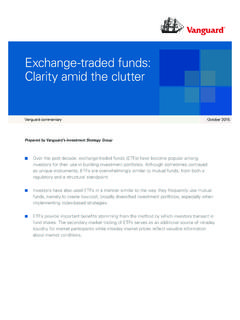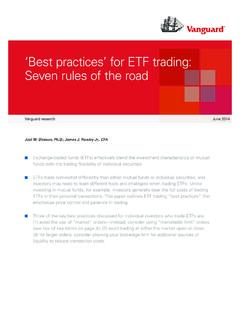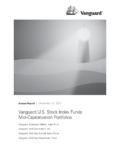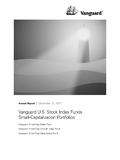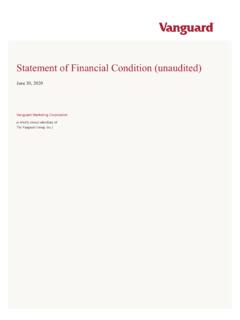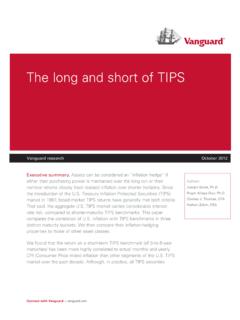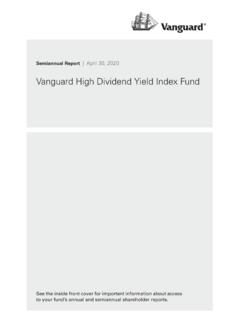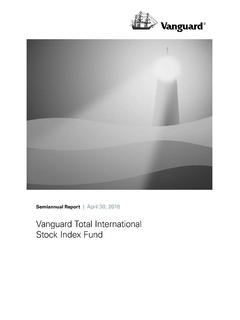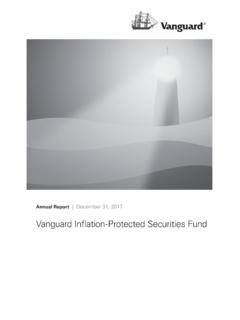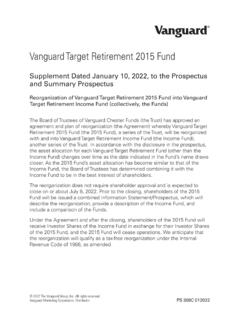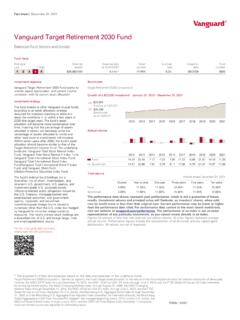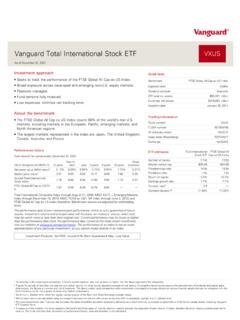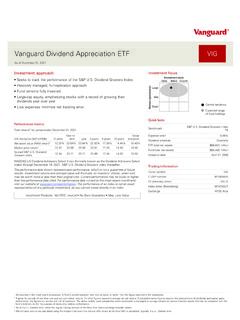Transcription of The case for low-cost index-fund investing - Vanguard
1 Vanguard Research April 2019 The case for low- cost index - fund investing Due to governmental regulatory changes, the introduction of exchange-traded funds (ETFs), and a growing awareness of the benefits of low- cost investing , the growth of index investing has become a global trend over the last several years, with a large and growing investor base. This paper discusses why we expect index investing to continue to be effective over the long term a rationale grounded in the zero-sum game, the effect of costs, and the challenge of obtaining persistent outperformance. We examine how indexing performs in a variety of circumstances, including diverse time periods and market cycles, and we provide investors with points to consider when evaluating different investment J. Rowley Jr., CFA, David J. Walker, CFA, and Carol ZhuAcknowledgments: The authors thank Garrett L.
2 Harbron and Daren R. Roberts for their valuable contributions. This paper is a revision of Vanguard research first published in 2004 as The case for Indexing by Nelson Wicas and Christopher B. Philips, updated in succeeding years by Mr. Philips and other co-authors. The current authors acknowledge and thank Mr. Philips and Francis M. Kinniry Jr. for their extensive contributions and original research on this on riskNotes about risk and performance data: Investments are subject to market risk, including the possible loss of the money you invest. Past performance is no guarantee of future returns. Bond funds are subject to the risk that an issuer will fail to make payments on time, and that bond prices will decline because of rising interest rates or negative perceptions of an issuer s ability to make payments.
3 Investments in stocks issued by companies are subject to risks including country/regional risk, which is the chance that political upheaval, financial troubles, or natural disasters will adversely affect the value of securities issued by companies in foreign countries or regions; and currency risk, which is the chance that the value of a foreign investment, measured in dollars, will decrease because of unfavorable changes in currency exchange rates. Stocks of companies based in emerging markets are subject to national and regional political and economic risks and to the risk of currency fluctuations. These risks are especially high in emerging markets. Funds that concentrate on a relatively narrow market sector face the risk of higher share-price volatility. Prices of mid- and small-cap stocks often fluctuate more than those of large-company stocks.
4 Government backing of Treasury or agency securities applies only to the underlying securities and does not prevent share-price fluctuations. Because high-yield bonds are considered speculative, investors should be prepared to assume a substantially greater level of credit risk than with other types of bonds. Diversification does not ensure a profit or protect against a loss in a declining market. Performance data shown represent past performance, which is not a guarantee of future results. Note that hypothetical illustrations are not exact representations of any particular investment, as you cannot invest directly in an index or fund -group investing1 was first made broadly available to investors with the launch of the first index mutual fund in 1976. Since then, low- cost index investing has proven to be an effective investment strategy over the long term, outperforming the majority of active managers across markets and asset styles (S&P Dow Jones Indices, 2015).
5 In part because of this long-term outperformance, index investing has seen exponential growth among investors, particularly in the United States, and especially since the global financial crisis of 2007 2009. In recent years, governmental regulatory changes, the introduction of indexed ETFs, and a growing awareness of the benefits of low- cost investing in multiple world markets have made index investing a global trend. This paper reviews the conceptual and theoretical underpinnings of index investing s ascendancy (along with supporting quantitative data) and discusses why we expect index investing to continue to be effective and to increase in popularity in the foreseeable market-capitalization-weighted indexed investment strategy via a mutual fund or an ETF, for example seeks to track the returns of a market or market segment with minimal expected deviations (and, by extension, no positive excess return) before costs, by assembling a portfolio that invests in the securities, or a sampling of the securities, that compose the market.
6 In contrast, actively managed funds seek to achieve a return or risk level that differs from that of a market-cap-weighted benchmark. Any strategy, in fact, that aims to differentiate itself from a market-cap-weighted benchmark ( , alternative indexing, smart beta or factor strategies ) is, in our view, active management and should be evaluated based on the success of the paper presents the case for low- cost index - fund investing by reviewing the main drivers of its efficacy. These include the zero-sum game theory, the effect of costs, and the difficulty of finding persistent outperfor-mance among active managers. In addition, we review circumstances under which this case may appear less or more compelling than theory would suggest, and we provide suggestions for selecting an active manager for investors who still prefer active management or for whom no viable low- cost indexed option is available.
7 1 Throughout this paper, we use the term index investing to refer to a passive, broadly diversified, market-capitalization-weighted strategy. Also for purposes of this discussion, we consider any strategy that is not market-cap-weighted to be an active strategy. 2 See Pappas and Dickson (2015), for an introduction to factor strategies. Chow et al. (2011) explained how various alternatively weighted index strategies outperformed market-cap-weighted strategies largely on the basis of factors. 3 See Sharpe (1991) for a discussion of the zero-sum game theory The central concept underlying the case for index - fund investing is that of the zero-sum game. This theory states that, at any given time, the market consists of the cumulative holdings of all investors, and that the aggregate market return is equal to the asset-weighted return of all market participants.
8 Since the market return represents the average return of all investors, for each position that outperforms the market, there must be a position that underperforms the market by the same amount, such that, in aggregate, the excess return of all invested assets equals Note that this concept does not depend on any degree of market efficiency; the zero-sum game applies to markets thought to be less efficient (such as small-cap and emerging market equities) as readily as to those widely regarded as efficient (Waring and Siegel, 2005).Figure 1 illustrates the concept of the zero-sum game. The returns of the holdings in a market form a bell curve, with a distribution of returns around the mean, which is the market return. It may seem counterintuitive that the zero-sum game would apply in inefficient markets, because, by definition, an inefficient market will have more price and informational inefficiencies and, therefore, more opportunities for outperformance.
9 Although this may be true to a certain extent, it is important to remember that for every profitable trade an investor makes, (an)other investor(s) must take the opposite side of that trade and incur an equal loss. This holds true regardless of whether the security in question is mispriced or not. For the same reason, the zero-sum game must apply regardless of market direction, including bear markets, where active management is often thought to have an advantage. In a bear market, if a manager is selling out of an investment to position the portfolio more defensively, another or others must take the other side of that trade, and the zero-sum game still applies. The same logic applies in any other market, as investors may still find active management appealing, as it seemingly would provide an even-odds chance of successfully outperforming.
10 As we discuss in the next section, though, the costs of investing make outperforming the market significantly more difficult than the gross-return distribution would of costs The zero-sum game discussed here describes a theoretical cost -free market. In reality, however, investors are subject to costs to participate in the market. These costs include management fees, bid-ask spreads, administrative costs, commissions, market impact, and, where applicable, taxes all of which can be significant and reduce investors net returns over time. The aggregate result of these costs shifts the return distribution to the 1. Market participants asset-weighted returns form a bell curve around market s returnSource: Vanguard . Market4 Survivorship bias and the effect of merged and closed funds on performance are discussed in more detail later in this 2 shows two different investments compared to the market.
